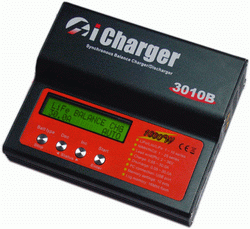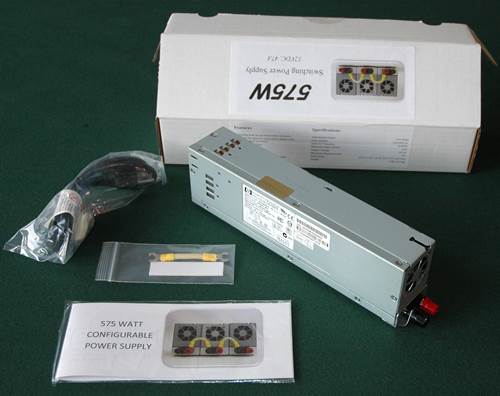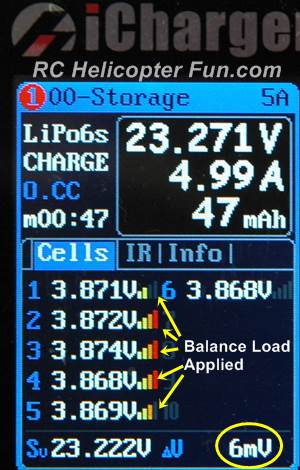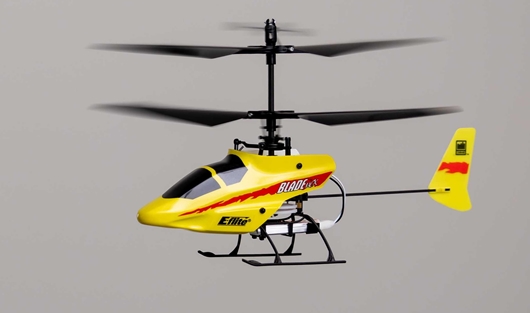iCharger 3010B & 306B Review
by John Salt
At 19 and 16 cents a Watt respectively, both the iCharger 3010B & 306B take near top rankings when it comes to power per dollar among this elite segment of RC battery chargers that boast high charge rates of 30 amps along with four digit Wattage ratings.
The iCharger 306B is pretty much exactly the same as the 3010B expect it can only support up to 6S LiPo's where as the 3010B will support up to 10S.
I already have two iCharger 208B’s and absolutely love the power and features they give, but when Dale at Buddy RC told me about the iCharger 3010B (coincidentally coinciding with the release of the power hungry Align T-Rex 700E 3G Heli that I’ve been drooling over) it was an easy decision to add this 1000 Watt 3010B charger to the family.
The Rex 700E will of course be a harder sell to the wife, but at least my high capacity/voltage charging needs are now well covered in hopeful anticipation for that big electric birds arrival. Having a charger like this to parallel charge six 6S 5000 mAh packs for example from a storage state in little over 30 minutes is a real treat and time saver.
That alone, never mind all the other features the 3010B & 306B have, is reason enough to put either of these bad boys on your “must have” list if you are into larger electric powered stuff or you're parallel charging a very large number of batteries.
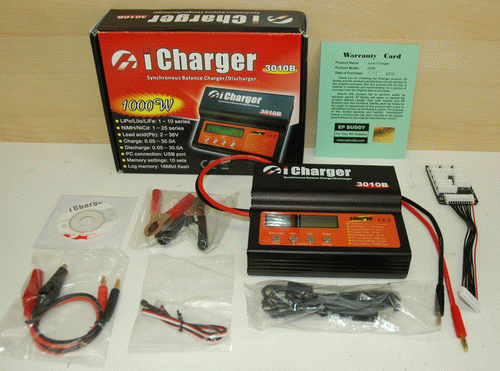 iCharger 3010B Unboxed
iCharger 3010B UnboxedAs you can see, like all of Junsi’s iChargers, the 3010B comes standard out of the box with a nice assortment of support accessories such as various power cables, battery clips, external temperature probe, USB cable, CD ROM with instructions & software, and of course your choice of balance board included at no charge by Dale.
What is not shown there is the one on one customer support you get from Dale when you purchase the iCharger 3010B or any other product he carries. I have been getting so many e-mails recently telling me how helpful Dale has been, so I know it just isn’t my experiences and why I so strongly recommend Buddy RC for your charger, power supply, and charging accessory needs. I too have bent Dale’s ear a few times while I was trying to figure out the software upgrade and LogView capabilities of these sophisticated iChargers and was so glad I was able to get that one on one help.
Back all that by what I consider to be the best RC battery charger warranty in the biz (one full year and once past the 1 year warranty period, Junsi will repair or replace any defective charger at no more than 50% of what a new one would cost) and it is fairly obvious why I am so fond of these chargers after wasting a fair amount of money on much less capable ones.
iCharger 3010B Power Requirements
The iCharger 3010B & 306B are of course very powerful chargers and that means they need a powerful power supply, at least if you want to use them to their full potential. You can use lower wattage/voltage power supplies or even a 12V car/power panel battery to power the 3010B or 306B but the output power will be limited. The input voltage range is actually very impressive with the 3010B & 306B operating anywhere from 4.5 volts to 38 volts DC but you need 22 volts or higher @ 1000 Watts or higher to achieve the full 1000 Watts of output power.
There is a nice little graph on the bottom of page 10 in the
iCharger 3010B instructions that shows the power output vs. input
voltage so you can get a good idea of the power output at different
input voltages. There is also an easy calculation formula on that page
to determine the maximum charge power capacity which helps make sense of
all this Wattage, voltage, current, and efficiency stuff.
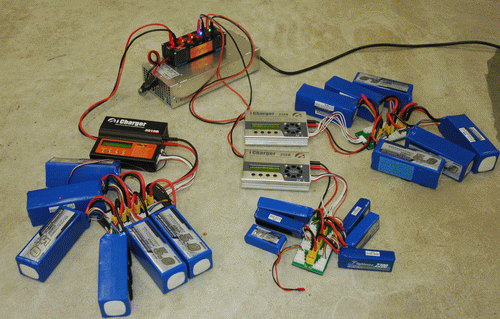 iCharger 3010B and 208B's Para Charing Multiple LiPo's
iCharger 3010B and 208B's Para Charing Multiple LiPo'sThe MeanWell 1000W 24V power supply being worked hard doing what it does best - "Juicing the Junsi's". I am pretty much maxing it out here at 40 amps total circuit load parallel charging to my heart's content. It was only running warm and had no problems keeping up.
The AC power cord that came with it was a different story however - it's just too small a gauge to handle the current and was approaching temperatures over 80 Celsius. I have since replaced it with a 12 gauge power cord and no more problem.
The internal cooling fan is fairly noisy because it's pushing a lot of air through the supply and the fan is on all the time regardless of load. A full day of electric flight suddenly got much easier!
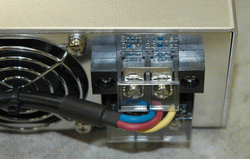
One thing I should mention about the MeanWell is it will accept both a 110VAC & 220VAC input voltage. For those of us with 110VAC house voltages, you must use the included jumper that comes with the power supply to short out the upper two terminals on the back of the power supply, this puts it in 110V mode.
Being the dumbass I am not reading the spec sheet, I failed to do that at first and the supply shut down every time I tried to power my chargers past about 12 amps. I almost called support, but I thought better have a look a the spec sheet. Just sharing the story in hopes it saves someone from a little embarrassment at my expense - LOL.
iCharger 3010B / 306B Features & Operation
I am not going to go over all the wonderful features the iCharger 3010B & 306B have, but I will go over a few of my favorite ones that I think you might also be interested in. If you already own an iCharger (106B, 206B , 208B, or 1010B) you will already be very familiar with most of these features and the operation of the 3010B & 306B are pretty much identical with the exact same easy and intuitive menu access and button layout. As with all the other iChargers, the 3010B & 306B clearly show all the settings and data on a 2 line by 16 character backlit LCD display.
The iCharger 3010B & 306B use the same efficient DC/DC converter system used in the rest of the iCharger line. Junsi calls this DC/DC conversion technology "synchronous buck-boost" and states that conversion efficiency can reach over 90%. What does this mean for you and me??? Basically a high quality RC battery charger with a wide input voltage range that runs cool, saves power, and comes in a very compact package saving precious bench space and making them very mobile for field charging.
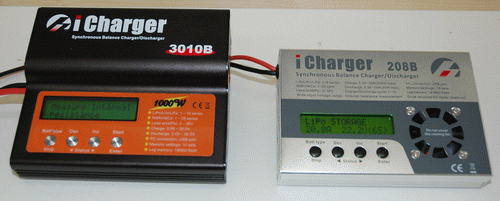 iCharger 3010B & 208B Size Comparison
iCharger 3010B & 208B Size ComparisonPictured above is the 1000 Watt iCharger 3010B next to the 350 Watt iCharger 208B. Size wise there isn’t much difference other than the back portion being a little taller to house the vertically mounted cooling fan and larger heat sinks. I actually found my iCharger 3010B ran cooler than my 208B charging the same battery type/voltage/capacity.
Not sure if it had to do with the better fan placement, but it was definitely noticeable. Pushing it to the full 30 amp output as I have done here charging six 5000 mAh 6S LiPo’s in parallel certainly shows the specs don’t lie and I couldn’t get over how cool the iCharger 3010B was after a full balance charge cycle on these fairly big packs.
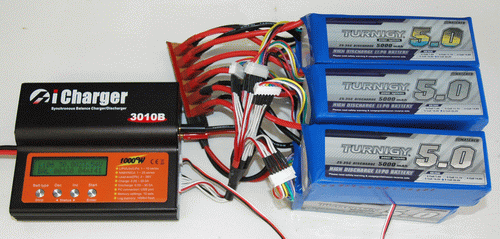 iCharger 3010B Para Charging @ 30 Amps
iCharger 3010B Para Charging @ 30 AmpsOf course the iCharger 3010B & 306B support all the common rechargeable battery types along with the three lithium battery chemistries (LiPo, Li-Ion, & LiFe).
Balance accuracy in any of the lithium modes is less than 10mV and like the other iChargers, you can select when balancing takes place in the charge cycle (always, during the last phase of charging-CV phase, or balance for storage).
The defaulted setting is to balance during the CV phase to get the most life out of your lithium packs.
Regenerative Discharge is a new feature on the 3010B & 306B but is now also available with all the iChargers by downloading the latest software (more on this in a bit). Regenerative Discharge is exactly that - it regenerates the power source when you perform a discharge cycle or a storage cycle when the iCharger will automatically determine if the pack has to charged to bring it up to storage voltage, or discharged to bring it down to storage voltage.
Regenerative Discharge will only work if you are powering your iCharger with a rechargeable battery source such as your power panel battery or car battery. For example, if at the end of the day, you have a few packs that weren’t used and are fully charged, instead of discharging them down to the storage voltage and dumping all that energy in heat, you can pump those mA’s back into the supply battery. With a little ingenuity and the right wiring harness, you can even dump some of that power from a few fully charged packs back into your discharged packs to bring them up to their storage voltage and help bring the fully charged ones down.
This might even save you from needing a boost (or the embarrassing phone call home) if you drain your car battery down too far while out at the flying field or race track. The really impressive thing is you can dump up to 1000 watts meaning the discharge rates in regenerative mode can be as high as 30 amps, provided your rechargeable power source can handle that amount of input charge.
Just like charging rates, regenerative discharge rates can of course be altered to suit your power source. If you enable “regenerative discharge” mode, the 3010B will prompt you before executing a discharge or storage cycle to ensure you don’t accidentally try to use it if you are powering your charger with a power supply – that would be bad thing…
As with most of today’s electronic devices that run on sophisticated software, the iCharger line of chargers all support software updates by means of the included USB cable, driver software, and iChargers website to access and download the latest software versions at no charge.
To tell you the truth, I am pretty useless when it comes to updating the software/firmware in most of my electronic thing-a-ma-jigs. I have a pretty hard time figuring it all out but I wanted that regenerative feature as well as some others on my 208B’s so I had to at least give it a try. Dale sent me detailed instructions, perfectly geared toward a computer dummy like me that walked me through the steps.
The last feature I would like to at least mention is the LogView software that the iCharger 3010B (and all other iChargers) support. Again, as with the firmware updates, this is something I never played around with on my 208B’s but I figured if I am going to be writing a review on the 3010B, I better at least know a bit about LogView.
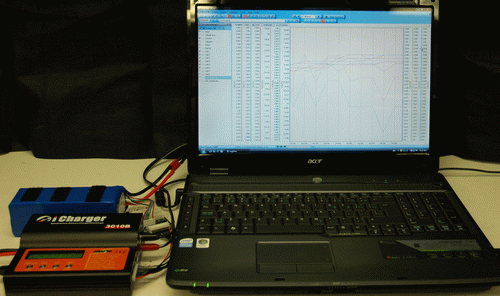 iCharger 3010B Hooked Up To LogView Software
iCharger 3010B Hooked Up To LogView SoftwareWhat a fun and interesting program to use along with your iChargers. If you are the “techie” type, or just like analyzing graphs and data, you will love this feature. Theory of how batteries function is all fine and dandy, but when you can “see” exactly what is going on in real time on a graphical display of so many different data fields, it really hits home.
Watching how the individual cell voltages on the graph all stabilize and come together during the balance phase of charging is pretty neat along with all the other data that is available in several different visual formats such as graphs, data rich charts, and analog gauges. You can save this data or screen shots as well for battery comparisons or to monitor a specific battery/s over the life of the pack/s.
Here's a link to LogView if you wanted to have a look at this powerful charging visualization software. This is German developed software and much of the site is only available in German but the software has both English and German versions when you download it.
Final Thoughts
If you are looking for a high power charger capable of a full 30 amp charge rate, that will charge and balance up to 10S LiPo packs, the iCharger 3010B costing $189.95 USD at Buddy RC (including shipping in the States) is pretty hard to top.
If you only need a 6S charger the 306B is the ticket. As mentioned at the beginning of this review, when you break that down to cost per Watt, the 3010B @ 19 cents a Watt and the 306B @16 cents a Watt offer the best value of any RC battery charger I have ever owned or considered purchasing.
After using (or should I say having a little too much fun playing around with) the iCharger 3010B and 306B, I honestly can’t say anything bad about them other than the somewhat complicated software issues I was having (most likely due to a loss of brain cells from sniffing too much nitro exhaust over the years) but Dale as I mentioned was very helpful getting me up to speed with it.
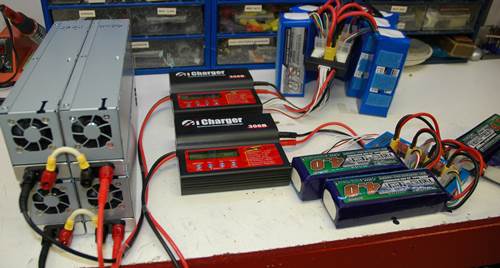
Now that summer is in full swing (and very short lived up here in Canada), I’m out flying almost every evening and the the iCharger 3010B and 306B are usually the first chargers I power up before dinner. Trying to scarf down a meal in less time then it takes to charge a half dozen big packs is certainly a new experience.
The iCharger 208B’s are not sitting idle and collecting dust; they are still pulling their share of the work load on the weekends as well proving the point that you hear all the time – “you can never have enough batteries, or enough charging power”.
I just got the iCharger 4010 Duo and this monster has taken some of the work load off my 3010B and 306B, but they still see plenty of action and have been going strong now for over 6 years!
